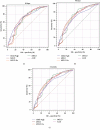Assessing the Prognostic Performance of the Child-Pugh, Model for End-Stage Liver Disease, and Albumin-Bilirubin Scores in Patients with Decompensated Cirrhosis: A Large Asian Cohort from Gastroenterology Department
- PMID: 32148566
- PMCID: PMC7048909
- DOI: 10.1155/2020/5193028
Assessing the Prognostic Performance of the Child-Pugh, Model for End-Stage Liver Disease, and Albumin-Bilirubin Scores in Patients with Decompensated Cirrhosis: A Large Asian Cohort from Gastroenterology Department
Retraction in
-
Retracted: Assessing the Prognostic Performance of the Child-Pugh, Model for End-Stage Liver Disease, and Albumin-Bilirubin Scores in Patients with Decompensated Cirrhosis: A Large Asian Cohort from Gastroenterology Department.Dis Markers. 2023 Jul 12;2023:9831059. doi: 10.1155/2023/9831059. eCollection 2023. Dis Markers. 2023. PMID: 37476625 Free PMC article.
Abstract
Background and Aim. Various methods, including the Child-Pugh score, the model for end-stage liver disease (MELD) score, the MELD combined with serum sodium concentration (MELD-Na) score, the integrated MELD (iMELD) score, and the albumin-bilirubin (ALBI) score, have been widely used for predicting the survival of decompensated cirrhosis (DeCi) patients. In this study, we defined and compared the prognostic value of these scores to predict mortality in DeCi patients.
Methods: We performed a single-center, observational retrospective study and analyzed 456 DeCi patients who were hospitalized in the gastroenterology department. The biochemical examination results and demographic characteristics of the patients were obtained, and five scores were calculated upon admission after 24 hours. All patients were observed until death, loss to follow-up, or specific follow-up times (28 days, 90 days, and 6 months). A receiver operating characteristic (ROC) curve was used to evaluate the ability of these methods to predict mortality in DeCi patients.
Results: At 28 days, 90 days, and 6 months, the cumulative number of deaths was 50 (11.0%), 76 (16.6%), and 91 (19.9%), respectively. The scores were significantly higher in nonsurviving patients than in surviving patients. All scores yielded viable values in predicting 28-day, 90-day, and 6-month prognoses for DeCi patients. The areas under the ROC curve (AUROCs) of the ALBI score were higher than those of the other scores, which were only over 0.700 at 28 days. The AUROC of the MELD score was higher than that of the other scores, including the MELD-Na and iMELD scores, at 90 days and 6 months.
Conclusion: All five methods (Child-Pugh score, MELD score, MELD-Na score, iMELD score, and ALBI score) provided a reliable prediction of mortality for both the short-term and long-term prognosis of patients with DeCi. The ALBI score may be particularly useful for assessing short-term outcomes, whereas the MELD score may be particularly useful for assessing long-term outcomes.
Copyright © 2020 Si-Zhe Wan et al.
Conflict of interest statement
The authors declare that there are no conflicts of interest.
Figures
References
-
- Murphy S. L., Xu J., Kochanek K. D. Deaths: final data for 2010. National Vital Statistics Reports. 2013;61(4):1–117. - PubMed
-
- Wang S. B., Wang J. H., Chen J., Giri R. K., Chen M. H. Natural history of liver cirrhosis in South China based on a large cohort study in one center: a follow-up study for up to 5 years in 920 patients. Chinese Medical Journal. 2012;125(12):2157–2162. - PubMed
Publication types
MeSH terms
Substances
LinkOut - more resources
Full Text Sources
Medical


